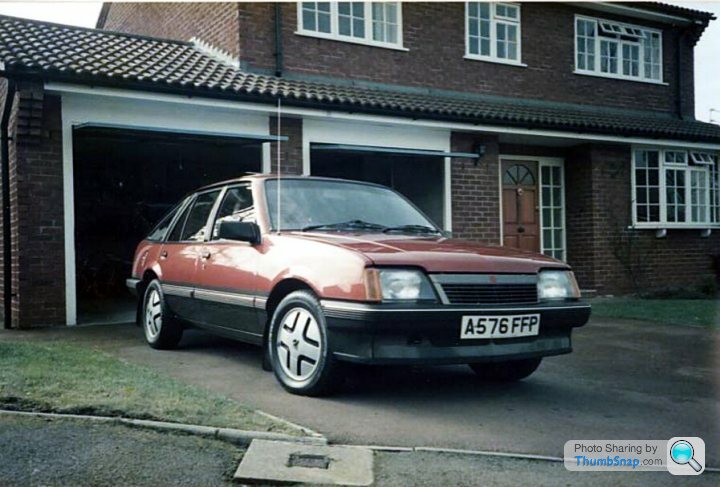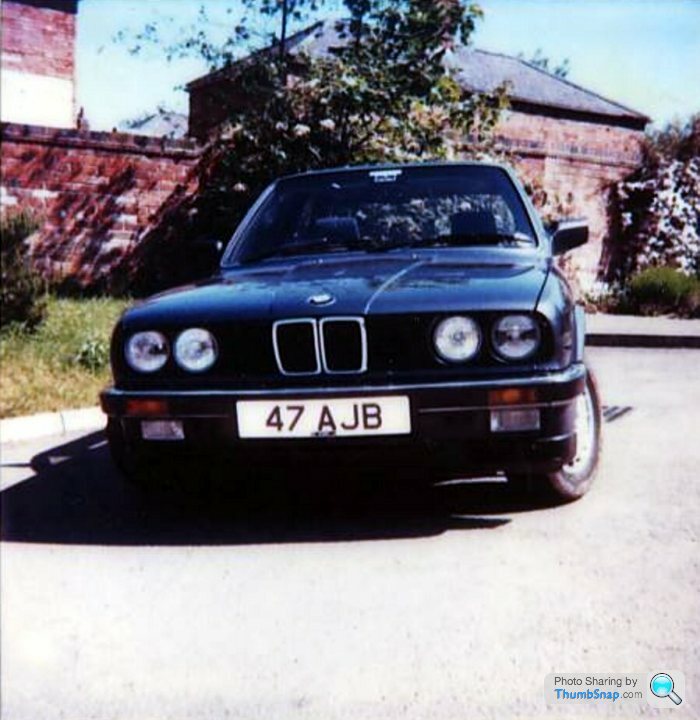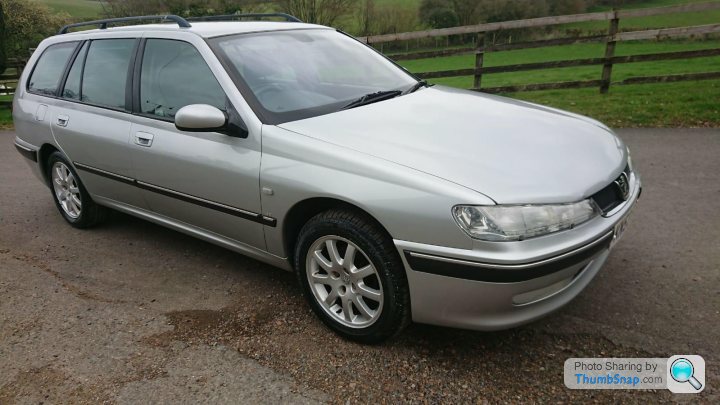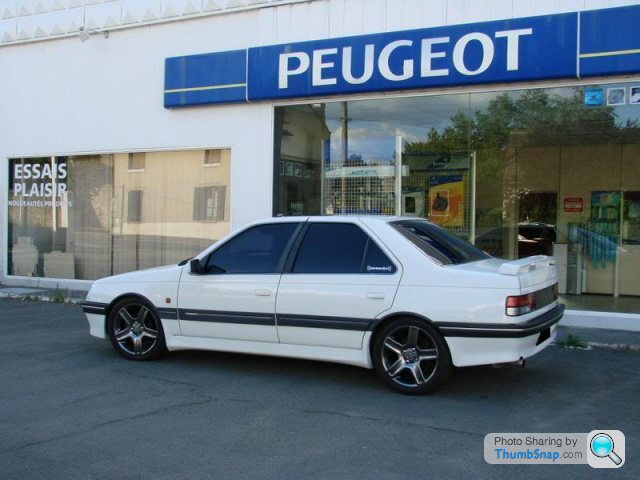New Peugeot 405. Less than £8,000
Discussion
In the early 90's I joined a big American firm based in Bracknell and would regularly commute to manufacturing and sales sites all over the UK. I was too low in the hierarchy to earn a company smoker so would have unhindered access to all that Eurodollar (remember them?) could offer from their "group C or below" range.
The 405 I remember having sublime handling and extremely comfortable seats. They were really well equipped too with leccy windows and air con, and a wand on the column to control the stereo. Also back then, contemporary diesel engines were dire - yet Peugeot knew what they were doing. The worst on offer to drive was probably the Mk 3 Cavalier and the ageing Sierra. The Passat with it's passive rear steer was surprisingly agile but the dark horse of the pov spec repmobile car park of mundanity was the old P10 Nissan Primera (which are probably all still doing sterling service as minicabs these days).
A few years later my housemate bought a 405 GTX 1.9 auto from a dodgy trader as a barge to schlep up and down the motorway each weekend to see his girlfriend, It was equipped like a V12 S Class and had similar running costs - it was so unreliable that the barely double digit fuel consumption was the least of his worries. A few years later he got a massive promotion and inherited the previous incumbent's barely run in E39 5 series - it was like a lottery win! My mate's experience plus mine at the hands of an equally unreliable s t-fest of an AX GT has severely dented my faith in French cars.
t-fest of an AX GT has severely dented my faith in French cars.
The 405 I remember having sublime handling and extremely comfortable seats. They were really well equipped too with leccy windows and air con, and a wand on the column to control the stereo. Also back then, contemporary diesel engines were dire - yet Peugeot knew what they were doing. The worst on offer to drive was probably the Mk 3 Cavalier and the ageing Sierra. The Passat with it's passive rear steer was surprisingly agile but the dark horse of the pov spec repmobile car park of mundanity was the old P10 Nissan Primera (which are probably all still doing sterling service as minicabs these days).
A few years later my housemate bought a 405 GTX 1.9 auto from a dodgy trader as a barge to schlep up and down the motorway each weekend to see his girlfriend, It was equipped like a V12 S Class and had similar running costs - it was so unreliable that the barely double digit fuel consumption was the least of his worries. A few years later he got a massive promotion and inherited the previous incumbent's barely run in E39 5 series - it was like a lottery win! My mate's experience plus mine at the hands of an equally unreliable s
 t-fest of an AX GT has severely dented my faith in French cars.
t-fest of an AX GT has severely dented my faith in French cars.Edited by Dapster on Thursday 18th April 03:44
Back in those days I never owned a Pug (and never in my life a Ford strangely) but I did own a Cavalier SRi and an E30 2.5 sport, which I ordered with aircon. Both were, compared to other rubbish around, pretty good cars and the silky-smooth engine of the straight six was always a pleasure. If the Cavalier had had power steering it too would have been exceptional at the price, which was £6,800 at the time. Can't find the 325i, but did find the 323i that preceded it.




The biggest problem I remember with the 405 was it's total lack of headroom. When I went to look at one as a company car the guys in the showroom just laughed and said you're welcome to try but you won't be able to sit up straight, and I'm only just 6' (or was back then).
I did like the handling, the first Mrs had one as a loaner for a while when the garage managed to drive a truck into her 309SRi.
The second Mrs had one as a replacement when the local Ford dealer couldn't work out why the brakes on her Onion would fail every time the ABS cut in.
They were short on headroom, but the chassis was great for the time, as others have pointed out, all the period reviews praised them. I certainly much preferred them to the Sierra, and the ride to the 316/318s or the Merc190 I had for a while. I don't remember the engine being up to much though, although both the ones we had as loaners were fairly basic level ones.
I did like the handling, the first Mrs had one as a loaner for a while when the garage managed to drive a truck into her 309SRi.
The second Mrs had one as a replacement when the local Ford dealer couldn't work out why the brakes on her Onion would fail every time the ABS cut in.
They were short on headroom, but the chassis was great for the time, as others have pointed out, all the period reviews praised them. I certainly much preferred them to the Sierra, and the ride to the 316/318s or the Merc190 I had for a while. I don't remember the engine being up to much though, although both the ones we had as loaners were fairly basic level ones.
PhillipM said:
It was intentionally designed in, much like in the 205 and 306, by way of twisting rear subframe with compliant mounts.
That's not remarkable in any way though. The tuning Peugeot did (and still do on their current cars) was to reduce oversteer at the rear...every car with a trailing arm rear suspension, where the mounts are forward of the axle centre line has compliance oversteer.Peugeot were good with chassis tuning, they still had to deal with the same issues as every other car maker using simple suspension designs.
There are bushes that can compensate somewhat for compliance oversteer, introducing some understeer, but they come with negative response characteristics too.
Basically, it's marketing rubbish. Trailing arm rear suspension always has passive rear steer, and always in the oversteer direction. It's not a great solution for the average/not aware driver.
Kawasicki said:
PhillipM said:
It was intentionally designed in, much like in the 205 and 306, by way of twisting rear subframe with compliant mounts.
That's not remarkable in any way though. The tuning Peugeot did (and still do on their current cars) was to reduce oversteer at the rear...every car with a trailing arm rear suspension, where the mounts are forward of the axle centre line has compliance oversteer.Peugeot were good with chassis tuning, they still had to deal with the same issues as every other car maker using simple suspension designs.
There are bushes that can compensate somewhat for compliance oversteer, introducing some understeer, but they come with negative response characteristics too.
Basically, it's marketing rubbish. Trailing arm rear suspension always has passive rear steer, and always in the oversteer direction. It's not a great solution for the average/not aware driver.
Yes it's suspension was simple on paper. MacPherson struts and semi trailing arms...popular at the time and indeed used on the E30 too.
Whatever point you are trying to get to while discussing the suspension, the fact remains that the road testers of the period felt the 405 had exceptional handling compared to anything it was put up against. That was the claim in the first post of this thread, and regardless of how Peugeot achieved that, it remains true.
It was a great handling car. It wasn't just great handling for what it was, it wasn't just great handling compared to other simple FWD alternatives or big cars, it was, simply, a very enjoyable and entertaining car to drive on a twisty road, no excuses or caveats needed.
kiseca said:
Kawasicki said:
PhillipM said:
It was intentionally designed in, much like in the 205 and 306, by way of twisting rear subframe with compliant mounts.
That's not remarkable in any way though. The tuning Peugeot did (and still do on their current cars) was to reduce oversteer at the rear...every car with a trailing arm rear suspension, where the mounts are forward of the axle centre line has compliance oversteer.Peugeot were good with chassis tuning, they still had to deal with the same issues as every other car maker using simple suspension designs.
There are bushes that can compensate somewhat for compliance oversteer, introducing some understeer, but they come with negative response characteristics too.
Basically, it's marketing rubbish. Trailing arm rear suspension always has passive rear steer, and always in the oversteer direction. It's not a great solution for the average/not aware driver.
Yes it's suspension was simple on paper. MacPherson struts and semi trailing arms...popular at the time and indeed used on the E30 too.
Whatever point you are trying to get to while discussing the suspension, the fact remains that the road testers of the period felt the 405 had exceptional handling compared to anything it was put up against. That was the claim in the first post of this thread, and regardless of how Peugeot achieved that, it remains true.
It was a great handling car. It wasn't just great handling for what it was, it wasn't just great handling compared to other simple FWD alternatives or big cars, it was, simply, a very enjoyable and entertaining car to drive on a twisty road, no excuses or caveats needed.
Kawasicki said:
That's not remarkable in any way though. The tuning Peugeot did (and still do on their current cars) was to reduce oversteer at the rear...every car with a trailing arm rear suspension, where the mounts are forward of the axle centre line has compliance oversteer.
Peugeot were good with chassis tuning, they still had to deal with the same issues as every other car maker using simple suspension designs.
There are bushes that can compensate somewhat for compliance oversteer, introducing some understeer, but they come with negative response characteristics too.
Basically, it's marketing rubbish. Trailing arm rear suspension always has passive rear steer, and always in the oversteer direction. It's not a great solution for the average/not aware driver.
You're completely wrong about it, and if you'd ever even glanced at a single Peugeot rear beam you'd know the bushes design in compliance to toe out the rear and aid in turn in.Peugeot were good with chassis tuning, they still had to deal with the same issues as every other car maker using simple suspension designs.
There are bushes that can compensate somewhat for compliance oversteer, introducing some understeer, but they come with negative response characteristics too.
Basically, it's marketing rubbish. Trailing arm rear suspension always has passive rear steer, and always in the oversteer direction. It's not a great solution for the average/not aware driver.
The trick Peugeot did was to make the actual arm and pivots very stiff indeed (needle bearing pivots, very stiff casings with the spring/damper/arb loads taken right by the pivot, etc) to reduce flex or complaince oversteer on the trailing arm and the actual toe out was designed to twist the entire subframe so that it would toe in the inner rear wheel when it toed out the outer and keep the overall toe-angle the same, rather than flex just the outer arm and bushes like a lot of other setups.
It's not what they did and still do, the later cars with multilink - 406, 407, etc, are all designed with a lot of toe in in both droop and bump on the rear to deliberately make the cars understeer at the limits. Completely the opposite to what the lauded 205, 309 and 405 did, and yes, while it's more stable the handling suffers for it.
In fact I'm currently making new toe-control arms for the rear of my 406 that remove a lot of it just to get the car a bit more neutral like the earlier cars.
And yes, the good handling was partly down to that, if you fit solid rear mounts for a track car, you can immediately notice how the turn in is numbed slightly and the car no longer allows you to adjust the line with the throttle input as much - something that it was praised for by many road testers in it's day.
TL:DR - not marketing rubbish, you've just got how they work completely backwards in your head.
Edited by PhillipM on Thursday 18th April 15:02
PhillipM said:
Kawasicki said:
That's not remarkable in any way though. The tuning Peugeot did (and still do on their current cars) was to reduce oversteer at the rear...every car with a trailing arm rear suspension, where the mounts are forward of the axle centre line has compliance oversteer.
Peugeot were good with chassis tuning, they still had to deal with the same issues as every other car maker using simple suspension designs.
There are bushes that can compensate somewhat for compliance oversteer, introducing some understeer, but they come with negative response characteristics too.
Basically, it's marketing rubbish. Trailing arm rear suspension always has passive rear steer, and always in the oversteer direction. It's not a great solution for the average/not aware driver.
You're completely wrong about it, and if you'd ever even glanced at a single Peugeot rear beam you'd know the bushes design in compliance to toe out the rear and aid in turn in.Peugeot were good with chassis tuning, they still had to deal with the same issues as every other car maker using simple suspension designs.
There are bushes that can compensate somewhat for compliance oversteer, introducing some understeer, but they come with negative response characteristics too.
Basically, it's marketing rubbish. Trailing arm rear suspension always has passive rear steer, and always in the oversteer direction. It's not a great solution for the average/not aware driver.
The trick Peugeot did was to make the actual arm and pivots very stiff indeed (needle bearing pivots, very stiff casings with the spring/damper/arb loads taken right by the pivot, etc) to reduce flex or complaince oversteer on the trailing arm and the actual toe out was designed to twist the entire subframe so that it would toe in the inner rear wheel when it toed out the outer and keep the overall toe-angle the same, rather than flex just the outer arm and bushes like a lot of other setups.
It's not what they did and still do, the later cars with multilink - 406, 407, etc, are all designed with a lot of toe in in both droop and bump on the rear to deliberately make the cars understeer at the limits. Completely the opposite to what the lauded 205, 309 and 405 did, and yes, while it's more stable the handling suffers for it.
In fact I'm currently making new toe-control arms for the rear of my 406 that remove a lot of it just to get the car a bit more neutral like the earlier cars.
And yes, the good handling was partly down to that, if you fit solid rear mounts for a track car, you can immediately notice how the turn in is numbed slightly and the car no longer allows you to adjust the line with the throttle input as much - something that it was praised for by many road testers in it's day.
TL:DR - not marketing rubbish, you've just got how they work completely backwards in your head.
Edited by PhillipM on Thursday 18th April 15:02
Explain to me how bushes on a trailing arm type suspension could be arranged to give anything other than toe out at the outer tyre in cornering.
A multilink suspension is normally designed to generate toe-in during bump, and toe-out during rebound. These toe characteristics aren’t typically used to tune limit handling balance, they are used to tune steering precision/response and straight line stability.
It is a good topic for a separate thread though.
Easy, you put the rear subframe mount behind the tyre contact patch and make it proportionally stiffer than the front mount.
The later 406 and 407 multilink rears generate toe in both on bump and rebound, it's very easy to see just from a quick glance at the setup, given the short toe-control arms.
The steering response and straightline stability is far more influenced by the static rear toe setting than it is from the roll-steer curves, which should be pretty obvious given the latter needs a lot of loading to achieve the toe in/out change.
Which is also why people swap trailing arms around on Peugeot setups to give them different base toe settings, in order to alter just the initial steering response, rather than changing bushes, which alters the cars responses under load much more.
Regardless, the vaunted and marketed passive rear steering in 90's Peugeots that you regard as just marketing rubbish is actually very deliberately designed in, you've only got to look at a front and rear 306 subframe bush to realise they intentionally made the rear bush very soft laterally and that the front bush is designed to rotate/flex as a pivot point.
The later 406 and 407 multilink rears generate toe in both on bump and rebound, it's very easy to see just from a quick glance at the setup, given the short toe-control arms.
The steering response and straightline stability is far more influenced by the static rear toe setting than it is from the roll-steer curves, which should be pretty obvious given the latter needs a lot of loading to achieve the toe in/out change.
Which is also why people swap trailing arms around on Peugeot setups to give them different base toe settings, in order to alter just the initial steering response, rather than changing bushes, which alters the cars responses under load much more.
Regardless, the vaunted and marketed passive rear steering in 90's Peugeots that you regard as just marketing rubbish is actually very deliberately designed in, you've only got to look at a front and rear 306 subframe bush to realise they intentionally made the rear bush very soft laterally and that the front bush is designed to rotate/flex as a pivot point.
Edited by PhillipM on Thursday 18th April 22:02
RobM77 said:
Bigger engines actually make most cars handle worse due to the weight. In all other respects, the chassis is identical between an E30 325i and a 318i. The optional LSD is debatable - personally I consider them a necessary evil (both my racing cars have them, so I'm used to them). So, if we're talking purely about handling, the 316i and 318i would actually be the peak of the range. All the 325i does better is concerning straight lines - the extra weight of the 6 cyl engine actually detracts from the handling.
Just for the record, chassis e not identical. There were many detail differences in suspension within the e30 range. Heavier models, such as all 325i, all tourings and six cylinder convertibles (so 320s as well as 325s) had different front struts, for example. 318s may still be best handling though. Though extra power
of 325 gives another element to "handling" in that the extra power gives an extra element of control.
Edited by Norfolkandchance on Friday 19th April 11:20
I bought a J reg (pre facelift) 405 GRDT saloon from a mate for £200 about 15 years ago. It had 200k miles, and about 3 weeks MOT. I remember being impressed with 4x electric windows, aircon, remote locking and an electric sunroof, which I don't think anything mid range from Vauxhall, Ford or the suchlike would have provided.
I had a play around with the electrics, that all worked. I then took it for an MOT to see how long the list would be, and it passed without any advisories !
I had a play around with the electrics, that all worked. I then took it for an MOT to see how long the list would be, and it passed without any advisories !
Glasgowrob said:
Good care in the day but the 406 was far and away superior
In fact I'd take a decent 406 today in either petrol or diesel
In fact I'd take a decent 406 today in either petrol or diesel

Picked up this low mileage fully loaded HDi recently... pulls like a train, awesome ride, handling and brakes and a lovely place to sit.
The last properly decent Peugeot in my opinion and many other agree.
Sheepshanks said:
Really - says who? Better than Sierra or 3 Series??
Oh yes. The Sierra wasn't bad but had crap dampers and the E30 was nothing special at all - low geared steering and all a bit seventies. The only 405 I drove was in 1989, a new 405GTX with the 1.9i engine. What a revelation, incredible fun to drive and so comfortable. The original Mondeo was the first car to really match it.Old Merc said:

During the 90`s I had a 405 MI16 X 4,probably the most underrated car at the time. 16v twin cam,4x4,LSD front and rear,active ride rear suspension, ABS, etc etc. I often traveled to Germany and it would do 150mph and stick to the road like glue.
The argument going on regards handling is interesting, obviously owning one I had a vested interest in keeping track of road testers opinions and there is no doubt in my mind they rated the 405 as the best handling saloon of the period. I think it was performance car that stated that, the magazine that Evo.... ‘evolved’ from. I have the road test book somewhere.
I think in those days road testers had quite different views to today’s testers. In those days they were not obsessed with oversteer, FWD was still seen as the future and they rated a car on how easily it could be driven very quickly, the 405 could as it was vice free and had superb damping. I’ve not driven that era of RWD car, apart from a Sierra which was crap..... very crap!. I’d expect Cars like the 3 series, and the 75 to be beautifuly balanced, but have tendency to go through a hedge backwards in hamfisted hands. A 405 probably wouldn’t it would warn you first allowing you to lift and it would come back into line.
Great to see The road rally one...... that is a proper test of a Cars ability on the back roads.
For those who don’t know what that sport is, do some research and see what is winning these days, you might be surprised!.
Gassing Station | Classic Cars and Yesterday's Heroes | Top of Page | What's New | My Stuff



